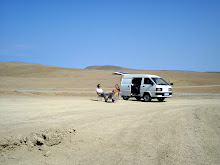On two tons of petrol, we drove 21.000 kilometres through 15 different countries. Surprisingly all border crossings were nearly hassle free, and we didn’t pay any bribes to corrupted officials. The most expensive part of the trip was through Turkey where petrol costs about 1.75 EUR per litre. The cheapest was Iran, with petrol for 0.07 EUR per litre, and no expenditure on alcohol.
The trip was a gamble from the start, because nobody could tell how good Shlakiyah’s 15 year old engine really is. It proved a prize in a raffle. No breakdowns, no flat tires. All we had to do was to change the engine oil and a bulb. Congratulations to Toyota!
As for the music; the most listened was Johnny Cash, who fitted well on endless roads.
The trip was a gamble from the start, because nobody could tell how good Shlakiyah’s 15 year old engine really is. It proved a prize in a raffle. No breakdowns, no flat tires. All we had to do was to change the engine oil and a bulb. Congratulations to Toyota!
As for the music; the most listened was Johnny Cash, who fitted well on endless roads.
